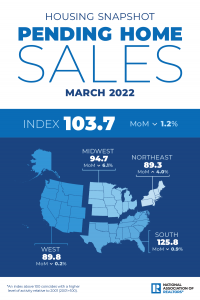NAR: Pending Home Sales Sag 1.2% in March

Pending home sales dropped in March, signifying five straight months that contract activity has declined, according to the National Association of Realtors®. Month-over-month, only the Northeast saw an increase in contract signings, while the three other major U.S. regions experienced declines in transactions. All four regions reported decreases in year-over-year contract activity.
Key Highlights
- Pending sales fell for the fifth consecutive month, down 1.2% in March from February.
- Pending sales rose in the Northeast and fell in the other three regions.
- Compared to the prior year, pending sales fell for the tenth consecutive month, by 8.2%, with pending sales down across all regions.
The Pending Home Sales Index (“PHSI”),* www.nar.realtor/pending-home-sales, a forward-looking indicator of home sales based on contract signings, fell 1.2% to 103.7 in March. Year-over-year, transactions sank 8.2%. An index of 100 is equal to the level of contract activity in 2001.
“The falling contract signings are implying that multiple offers will soon dissipate and be replaced by much calmer and normalized market conditions,” said Lawrence Yun, NAR’s chief economist. “As it stands, the sudden large gains in mortgage rates have reduced the pool of eligible homebuyers, and that has consequently lowered buying activity.
“The aspiration to purchase a home remains, but the financial capacity has become a major limiting factor.”
Yun expects the 30-year fixed mortgage rate to reach 5.3% by the fourth quarter, mortgage rates to average 4.9% in 2022, and to hit 5.4% by 2023.
He forecasts inflation to average 8.2% in 2022, although it will start to moderate to 5.5% in the second half of this year.
As of March 2022, higher mortgage rates and sustained price appreciation has led to a year-over-year increase of 31% in mortgage payments.
“Overall existing-home sales this year look to be down 9% from the heated pace of last year,” said Yun. “Home prices are in no danger of decline on a nationwide basis, but the price gains will steadily decelerate such that the median home price in 2022 will likely be up 8% from last year.”
While costs have soared for existing and new homes, rental properties have seen monthly payments jump, too, a turn that Yun says will lead to more renters exploring ownership.
“Fast-rising rents will encourage renters to consider buying a home, though higher mortgage rates will present challenges,” Yun said. “Strong rent growth nonetheless will lead to a boom in multifamily housing starts, with more than 20% growth this year.”
He predicts the unemployment rate will average 3.7% in 2022 and estimates gross domestic product to expand 2.8%.
With rising mortgage rates, Yun added that single-family homebuilders will be more cautious, despite the current tight inventory conditions, saying “I expect that to result in a boost to construction of less than 5%.”
March Pending Home Sales Regional Breakdown
Month-over-month, the Northeast PHSI grew 4.0% to 89.3 in March, a 9.2% fall from a
year ago. In the Midwest, the index dropped 6.1% to 94.7 last month, down 4.8% from March 2021.
Pending home sales transactions in the South decreased 0.9% to an index of 125.8 in March, down 9.5% from March 2021. The index in the West declined 0.2% in March to 89.8, down 8.4% from a year prior.
The National Association of Realtors® is America’s largest trade association, representing more than 1.5 million members involved in all aspects of the residential and commercial real estate industries.
# # #
*The Pending Home Sales Index is a leading indicator for the housing sector, based on pending sales of existing homes. A sale is listed as pending when the contract has been signed but the transaction has not closed, though the sale usually is finalized within one or two months of signing. Pending contracts are good early indicators of upcoming sales closings. However, the amount of time between pending contracts and completed sales is not identical for all home sales. Variations in the length of the process from pending contract to closed sale can be caused by issues such as buyer difficulties with obtaining mortgage financing, home inspection problems, or appraisal issues. The index is based on a sample that covers about 40% of multiple listing service data each month. In developing the model for the index, it was demonstrated that the level of monthly sales-contract activity parallels the level of closed existing-home sales in the following two months. An index of 100 is equal to the average level of contract activity during 2001, which was the first year to be examined. By coincidence, the volume of existing-home sales in 2001 fell within the range of 5.0 to 5.5 million, which is considered normal for the current U.S. population.
NOTE: Existing-Home Sales for April will be reported May 19. The next Pending Home Sales Index will be May 26; all release times are 10:00 a.m. ET.
Contact:
Quintin Simmons – Media Contact – (202)383-1178
Source: National Association of Realtors


